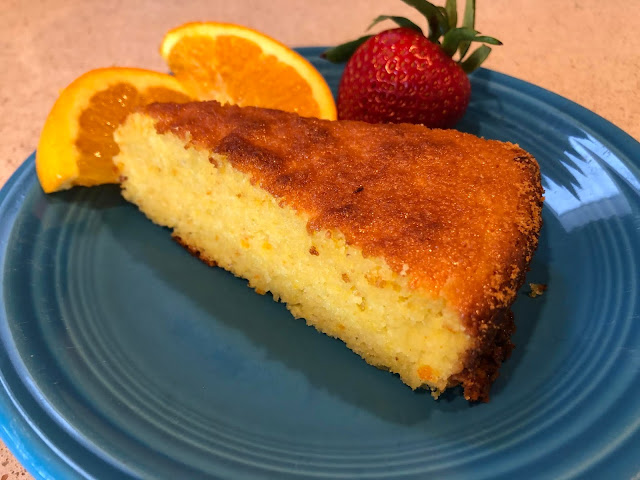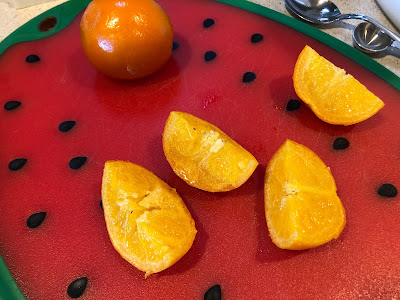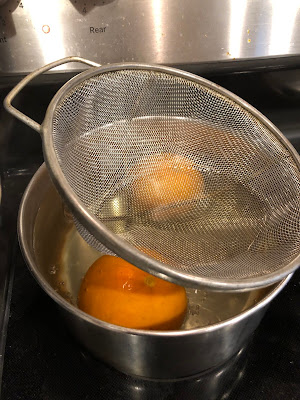
Recipe: No gluten or dairy in almond-based treat

(Photos: Kathy Morrison) |
My Washington navel orange tree still has plenty of fruit, so I'm thrilled to find more recipes that show off citrus. The lovely cake here has several bonus traits: It's gluten-free and uses no dairy products, and it easily can be dressed up for special occasions.
I chose to serve it plain, with some orange slices and strawberries on the side, for Sunday breakfast. But with some sweetened whipped cream or a fruit compote or even a Grand Marnier glaze, it would fill the role of company dessert with no problem. The texture is more like pudding cake than a standard layer cake, so it will stay moist even without adornments.

|
The trick here is the treatment of the oranges: They're scrubbed and then boiled whole for two hours. This treatment turns the pith and skin tender, removing the bitterness. The cooled oranges are whirred in a food processor or blender, then combined with the remaining ingredients and baked in a deep cake pan, preferably one with a removable base.
I'd be intrigued to try this recipe again with Meyer lemons, Cara Cara or blood oranges, or even pink grapefruit.
This recipe has its origins in Middle Eastern cooking and was published by Claudia Moren in "Everything Tastes Better Outdoors" (Knopf, 1984). It was picked up by the New York Times and later published in Kristen Miglore's " Genius Recipes ," the first cookbook from the Food52.com website (Tenspeed Press, 2015).
The NYT Cooking site is especially useful, I find, because so many home cooks try the recipes and note their adjustments and variations. In this case, a warning from several people to bake the cake at a slighter lower temperature (375 degrees F. instead of 400) and for 15 minutes less time was crucial: My cake came out perfectly golden brown at the revised time of 45 minutes.
Note: If you haven't baked with almond meal (also called almond flour), it's just finely ground almonds. You can grind your own from blanched whole almonds if you like, but I prefer the convenience. Look for almond meal in stores' natural foods bins if you don't want to spring for a whole package, such as from Bob's Red Mill.
Almond & Orange Cake
Adapted from the version in "Genius Recipes"
Serves 8-10
Ingredients:
2 large whole oranges, scrubbed
6 large eggs
2 cups plus 2 tablespoons almond meal
1 cup plus 2 tablespoons granulated sugar
1 teaspoon baking powder
1/2 teaspoon salt
Oil or butter for the pan
More ground almonds or flour, for the pan
Instructions:

the water. |
Place the clean oranges in a medium saucepan and cover with cold water. Bring water to a boil, turn the heat down to medium, and cook the oranges for 2 hours. (You might have to add some hot water during cooking if the level drops too low in the pan.) Oranges float, so I placed a metal sieve on top of the pan to keep the fruit submerged.
Drain off the water and let the oranges cool. (This can be done the day before baking; oranges can be kept at room temperature or in the refrigerator.)
When you're ready to bake, preheat the oven to 375 degrees. Grease the pan with oil or butter, then coat with almond meal or flour. (Optional if you aren't using a pan with a removable base: Grease the pan, add a parchment paper round to the bottom of the pan, then grease the paper and proceed with coating the pan with meal or flour.)
Cut open the oranges to check for and remove any seeds. Grind the orange pieces in a blender or food processor, or push them through a metal sieve, until they form a mostly smooth butter.
Beat together the orange puree and the eggs in a bowl. Stir in the almond meal, sugar, baking powder and salt, mixing thoroughly. Pour the batter into the prepared pan, smoothing the top.
Bake for 45 minutes or until golden brown and cake starts to pull away from the pan's sides. (The toothpick check does not work with this cake since it's quite moist.) Let cake cool in pan -- for at least 10 minutes if pan has a removable base, or until mostly cool if it does not. Turn out cake and let it finish cooling.
Serve plain, or with fruit, whipped cream or a thin glaze, as desired.
Comments
0 comments have been posted.Sacramento Digs Gardening to your inbox.
Sites We Like
Garden Checklist for week of April 21
This week there’s plenty to keep gardeners busy. With no rain in the immediate forecast, remember to irrigate any new transplants.
* Weed, weed, weed! Get them before they flower and go to seed.
* April is the last chance to plant citrus trees such as dwarf orange, lemon and kumquat. These trees also look good in landscaping and provide fresh fruit in winter.
* Smell orange blossoms? Feed citrus trees with a low dose of balanced fertilizer (such as 10-10-10) during bloom to help set fruit. Keep an eye out for ants.
* Apply slow-release fertilizer to the lawn.
* Thoroughly clean debris from the bottom of outdoor ponds or fountains.
* Spring brings a flush of rapid growth, and that means your garden is really hungry. Feed shrubs and trees with a slow-release fertilizer. Or mulch with a 1-inch layer of compost.
* Azaleas and camellias looking a little yellow? If leaves are turning yellow between the veins, give them a boost with chelated iron.
* Trim dead flowers but not leaves from spring-flowering bulbs such as daffodils and tulips. Those leaves gather energy to create next year's flowers. Also, give the bulbs a fertilizer boost after bloom.
* Pinch chrysanthemums back to 12 inches for fall flowers. Cut old stems to the ground.
* Mulch around plants to conserve moisture and control weeds.
* From seed, plant beans, beets, cantaloupes, carrots, corn, cucumbers, melons, radishes and squash.
* Plant onion sets.
* In the flower garden, plant seeds for asters, cosmos, celosia, marigolds, salvia, sunflowers and zinnias.
* Transplant petunias, zinnias, geraniums and other summer bloomers.
* Plant perennials and dahlia tubers for summer bloom.
* Mid to late April is about the last chance to plant summer bulbs, such as gladiolus and tuberous begonias.
* Transplant lettuce seedlings. Choose varieties that mature quickly such as loose leaf.